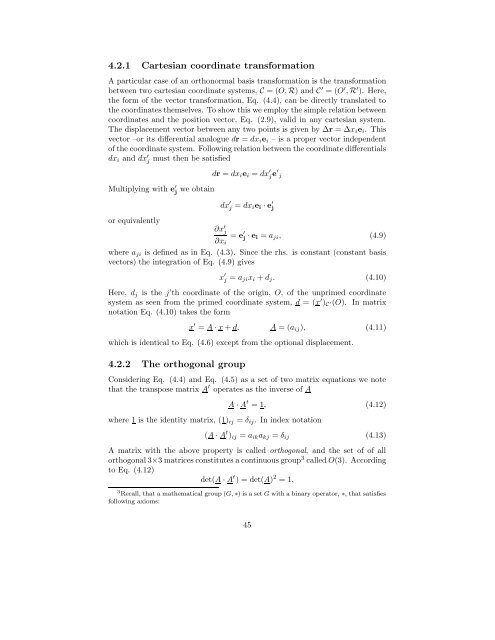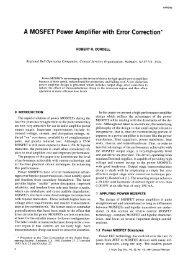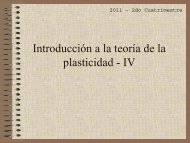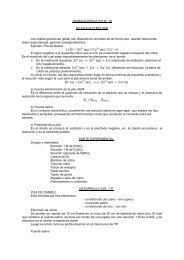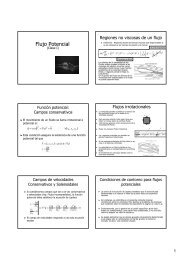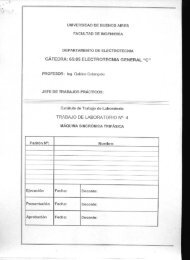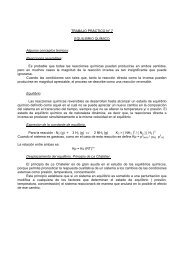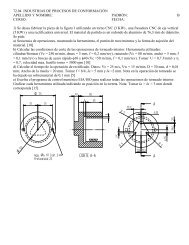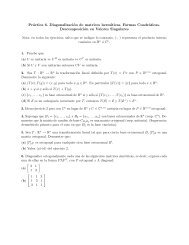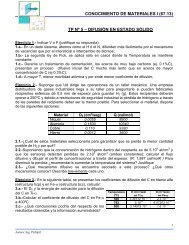Introduction to vector and tensor analysis
Introduction to vector and tensor analysis
Introduction to vector and tensor analysis
You also want an ePaper? Increase the reach of your titles
YUMPU automatically turns print PDFs into web optimized ePapers that Google loves.
4.2.1 Cartesian coordinate transformation<br />
A particular case of an orthonormal basis transformation is the transformation<br />
between two cartesian coordinate systems, C = (O, R) <strong>and</strong> C ′ = (O ′ , R ′ ). Here,<br />
the form of the vec<strong>to</strong>r transformation, Eq. (4.4), can be directly translated <strong>to</strong><br />
the coordinates themselves. To show this we employ the simple relation between<br />
coordinates <strong>and</strong> the position vec<strong>to</strong>r, Eq. (2.9), valid in any cartesian system.<br />
The displacement vec<strong>to</strong>r between any two points is given by ∆r = ∆xiei. This<br />
vec<strong>to</strong>r –or its differential analogue dr = dxiei – is a proper vec<strong>to</strong>r independent<br />
of the coordinate system. Following relation between the coordinate differentials<br />
must then be satisfied<br />
dxi <strong>and</strong> dx ′ j<br />
Multiplying with e ′ j<br />
or equivalently<br />
we obtain<br />
dr = dxiei = dx ′ j e′ j<br />
∂x ′ j<br />
dx ′ j = dxiei · e ′ j<br />
= e ′ j · ei = aji, (4.9)<br />
∂xi<br />
where aji is defined as in Eq. (4.3). Since the rhs. is constant (constant basis<br />
vec<strong>to</strong>rs) the integration of Eq. (4.9) gives<br />
x ′ j = ajixi + dj. (4.10)<br />
Here, dj is the j’th coordinate of the origin, O, of the unprimed coordinate<br />
system as seen from the primed coordinate system, d = (x ′ )C ′(O). In matrix<br />
notation Eq. (4.10) takes the form<br />
x ′ = A · x + d, A = (aij), (4.11)<br />
which is identical <strong>to</strong> Eq. (4.6) except from the optional displacement.<br />
4.2.2 The orthogonal group<br />
Considering Eq. (4.4) <strong>and</strong> Eq. (4.5) as a set of two matrix equations we note<br />
that the transpose matrix A t operates as the inverse of A<br />
A · A t = 1, (4.12)<br />
where 1 is the identity matrix, (1)ij = δij. In index notation<br />
(A · A t )ij = aikakj = δij<br />
(4.13)<br />
A matrix with the above property is called orthogonal, <strong>and</strong> the set of of all<br />
orthogonal 3×3 matrices constitutes a continuous group 3 called O(3). According<br />
<strong>to</strong> Eq. (4.12)<br />
det(A · A t ) = det(A) 2 = 1,<br />
3 Recall, that a mathematical group (G, ∗) is a set G with a binary opera<strong>to</strong>r, ∗, that satisfies<br />
following axioms:<br />
45


